[ad_1]
If you clicked on this article, you have probably read reviews or watched videos about AMD’s latest CPU release, the Ryzen 7 7800X3D. Typically, we would have pushed our review out alongside the masses at launch. However, we needed to take a beat with this one.
As we looked at our goal for this review–to give you the best box-to-build assessment that we could, it meant that we would need to be late to the party. Why? We experienced some odd stability issues that we wanted to ensure were not present with Day One drivers and BIOS. After retesting everything on multiple platforms, we can confidently report to you that what we experienced was anomalous, but we wanted to be careful!
Hopefully, that didn’t scare you off, because the Ryzen 7 7800X3D is an astonishing piece of hardware! We had a hunch it would be. After all, in our early coverage of the Ryzen 7000 Series, we pointed out that the best value-for-dollar processor in the Ryzen 7000 Series stack was the Ryzen 7700X. While our opinion holds mostly, the Ryzen 7 7800X3D made us ask ourselves some serious questions.
The Ryzen 7 7800X3D is one of three 3D V-cache equipped Zen 4 processors, but it, like this review, has arrived fashionably late to the party started by the Ryzen 9 7900X3D and Ryzen 9 7950X3D at the end of February. And the 7800X3D has made quite the entrance.
While it’s poised to be “the best gaming CPU” within its category, a multitude of 3rd party tests – including our own–show that the 7800X3D is an absolute problem child–upsetting the whole CPU hierarchy in gaming performance by matching or beating the performance of both Intel’s Core i9-13900K and AMD’s 7950X3D.
This is all a bit confusing, so we’re going to need to dive into some exposition on 3D V-cache and how these CPUs work first… and there is going to be a bit of it.
Cache is (Still) Gaming’s Kingmaker
We covered some of these details in our review of the Ryzen 9 7950X3D, but it is worth revisiting.
AMD’s 3D V-cache technology takes those thicc n’ beefy Zen 4 cores that we know and love, slims them down ever so slightly, and stacks an extra layer of L3 cache on top of the chiplet without increasing the overall vertical (or Z-) height of the CPU. This design allows the CPU die to have direct access to the cache, providing a faster memory resource than your system RAM.
In gaming scenarios, this buffed up cache helps the CPU when rapid access to random data is essential. Because player-driven actions are a random process, the 3D V-cache assists your CPU by recalling textures, animations, game physics, character placement, and more. While system RAM assists with this as well, the latency is much lower because instructions don’t have to travel far. The end result is better overall gaming performance.
(You can find AMD’s breakdown of 3D V-cache technology here if you are interested in learning more.)
This technology has been largely successful, with the Ryzen 7 5800X3D serving as the upstart that started it all last year. Fast forward to the present and one product generation later, and we now have three current generation Ryzen CPUs swimming in cache.
But this is where things divert a bit.
If you look at the design of the Ryzen 9 CPUs, the 7900 and 7950 (in their X, non-X, and X3D variants) each has a core complex die (CCD) made up of, as the name implies, two core complexes (CCX). While the X3D processors in the Ryzen 9 family also have two core complexes, only one CCX is equipped with the 3D V-cache.
As shared before, AMD’s official word is that they did not see a significant enough uplift in performance in the Ryzen 9 CPUs to justify the extra cost of equipping the second CCX with 3D V-cache. Instead, they would rely on Windows processes like Game Bar to whitelist games to utilize V-cache equipped cores while parking the others.
This system allows the V-cache equipped CCX to shine in gaming scenarios while the heftier, high clocked CCX does the heavy lifting in productivity. It’s a revolutionary system, but in day-to-day operations, it is rather inconsistent.
The Ryzen 7 7800X3D, however, only has a single CCX. It does not need to be told which CCX to prioritize and which one to park because there is no division. The 7800X3D is just steeped in that sweet, sweet cache, baby!
Enough with the chatter, let’s get deeper into the details.
Similar AMD Hood, Slightly Different AMD Hardware
The 7800X3D bears the Ryzen 7 name – a category defined by its 8-core, 16-thread (8C/16T) makeup. While core count is the same as its Ryzen 7 family, the AMD Ryzen 7 7800X3D has a slightly slower base and boost clock than the Ryzen 7 7700X. Where the 7700X has a base clock speed of 4.5 GHz and boost speeds up to 5.4 GHz, the 7800X3D trots slightly behind with a base clock speed of 4.2 GHz and max boost speeds up to 5.0 GHz.
However, when it comes to power draw, the 7800X3D does pack on 15W on top of the 7700X’s 105W TDP for a modest 120W. This does match the TDP of the other X3D CPUs, but we will see what the 7800X3D does with that power. You might be surprised.
In our productivity charts, you are going to see data from the entire Ryzen 7000 Series stack as well as Intel’s 13th Generation Core i5-13600K and Core i9-13900K. However, in gaming, we wanted to narrow the field to the current high end contenders. Since this is a battle for the crown, we’ll be positioning the Ryzen 7 7800X3D against the Core i9-13900K and Ryzen 9 7950X3D.
All of this data was collected utilizing a similar testing environment and methodology to keep things as clean as possible, but, as always, your mileage may vary. The numbers you are about to see represent box-to-build performance with little-to-no tweaks and consistent settings. The only advantage we gave each platform was that we enabled an AMD EXPO of XMP profile for low memory latency and speed.
Here is the hardware we used to collect our data from the Ryzen 7 7800X3D:
- Gigabyte X670E AORUS MASTER motherboard
- AMD Radeon RX 7900 XTX GPU
- 32 GB G.Skill Trident Z5 NEO DDR5-6000 RAM
- 1TB XPG ATOM 50 NVMe SSD
- NZXT C1200 Gold 1200W power supply
- NZXT Kraken Z73 360mm all-in-one liquid cooler with three 120mm fans
- NZXT H9 Elite mid-tower PC case with two 140mm fans as well as three 120mm fans
Productivity Is Not the Sweet Spot, But The 7800X3D Still Does the Work
We ran a suite of software benchmarks to highlight single and multi thread performance in scenarios designed to test how each CPU performed under various computational loads.
In our productivity tests, the Ryzen 7 7800X3D performs adequately, but the extra V-cache does not really make it stand out in the crowd. In some respects, it actually falls slightly behind the Ryzen 5 7600.
Here is what we found:

Geekbench 5 gives us a picture of single thread CPU performance for every day operations such as image and text compression, web navigation, machine learning, and .PDF rendering. In this benchmark, the Ryzen 7 7800X3D underperformed when compared to its Ryzen 7 counterparts. When looking at the numbers across the board, the 7800X3D paces closer to the Core i5-13600K than its own family of CPU.
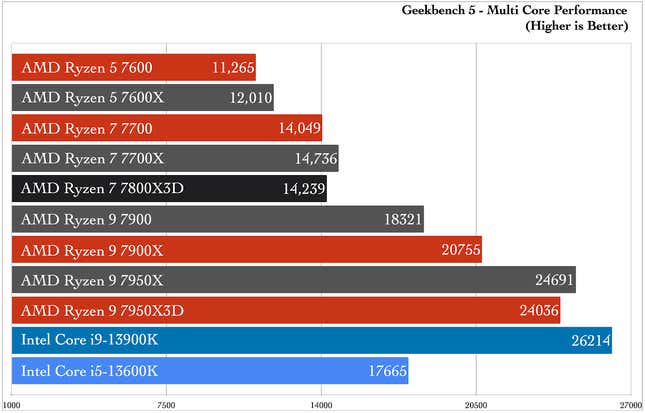
In multi-core performance, the 7800X3D catches up to its Ryzen 7 family while falling slightly behind the 7700X. Since the 7700X leads the 7800X3D in overall frequency, this is unsurprising. Like the 7950X3D, this could be a scenario where the extra cache just doesn’t give any benefit. That being said, it was good to see the 7800X3D catch up with its family!
We see a similar story in Handbrake:
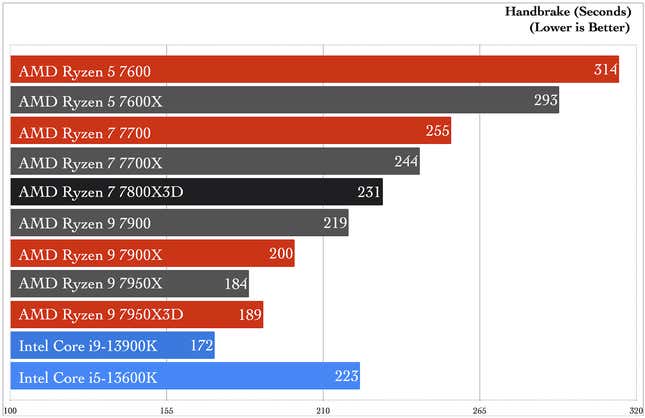
While rendering a 4K video down to 1080p30, the 7800X3D rendered slightly faster than the 7700X while trailing behind the 7900. However, it is worth noting that this test was one that caused our testing bench to crash on multiple occasions. We’ll talk a little bit more about that when we look at thermal performance.
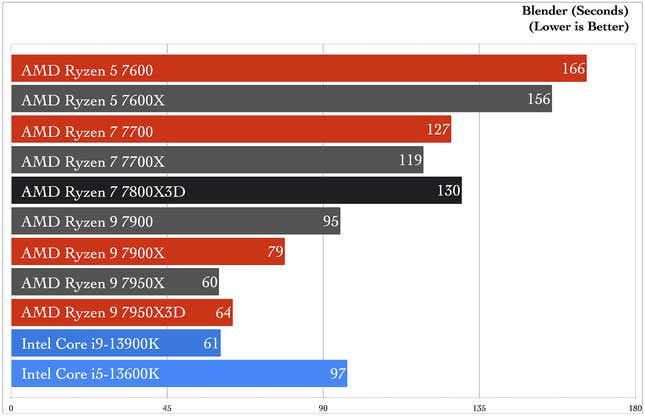
In Blender, the 7800X3D lagged behind the 7700 while rendering an image of a shiny red BMW. This image took the 7800X3D just over two minutes to render, putting it 3 seconds behind the Ryzen 7 7700 while putting considerable distance between itself and the Ryzen 5 family. Again, this is a situation where we don’t see the V-cache helping CPU performance.
Like the Ryzen 9 7950X3D, we did not see an overall benefit or uplift in performance in our productivity benchmarks. That doesn’t mean that the 7800X3D can’t perform at serviceable levels, it just means that the X3D chips are not the CPUs for these workloads.
The job for the X3D CPUs, however, is gaming.
Simplicity Beats Complexity in Gaming
Weird question: are you familiar with Occam’s razor?
It’s a problem-solving principle that roughly translates into English as this: “entities must not be multiplied beyond necessity.” Or, to reduce it even further: “the simplest explanation is usually the best one.”
When translating that to computers, we can take it to mean “fewer complexities means fewer opportunities for things to go wrong.”
Keep that in mind as we take a look at the numbers:
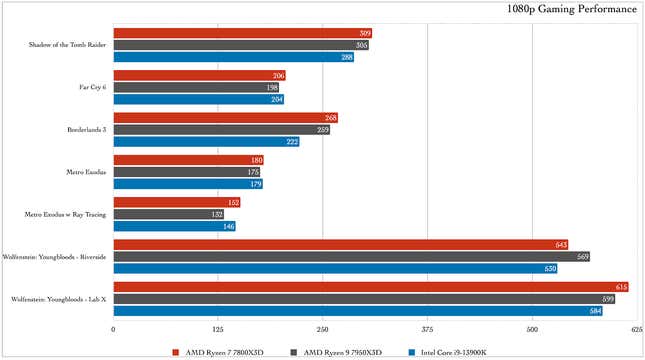
In most of our gaming scenarios at 1080p, the Ryzen 7 7800X3D either matched or led the Intel Core i9-13900K and AMD’s own flagship gaming CPU, the Ryzen 9 7950X3D. While some of these numbers are within too close of a margin to declare a winner, we saw some significant outliers where we saw a performance delta of ~7% to ~20% between the Core i9 and the 7800X3D as well as deltas separating it and the 7950X3D up to ~15%.
Now, there is more to this story… and this data could age like fine milk. So, why present it?
Let’s go back to Occam’s razor for a second; I believe we see this principle at work in our gaming benchmarks of the 7800X3D when compared to the 7950X3D at the time of writing this review.
Remember: the 7950X3D is built with two different core complexes–one with the V-cache and one without. That CPU is dependent on instructions from Windows to part some cores while prioritizing others. In AMD’s own words, they did not put V-cache on both complex cores of the Ryzen 9 because they didn’t see marked improvement in performance with more than one core complex equipped.
In one sense, they followed Occam’s razer – they did not “multiply beyond necessity,” at least, one the hardware end of things. They did, however, multiply the instructions needed to leverage the technology. And that is where we are seeing the difference.
Right now, we’re seeing the 7800X3D take the performance lead in gaming because it’s kept things simple. The 7800X3D has a single core complex equipped with 3D V-cache. It isn’t looking for instructions for which core complex to use because it only has one–it literally can’t go anywhere else with gaming processes!
And it handles those gaming processes like the absolute monster it is.
AMD Ryzen 7 7800X3D Energy Efficiency and Thermal Performance
When we saw the initial announcement for the Ryzen 7000X3D CPUs, one of the points that we noticed immediately on the product infographic was the TDP for the X3D CPUs in relation to the closest counterpart.
Here is what we found:
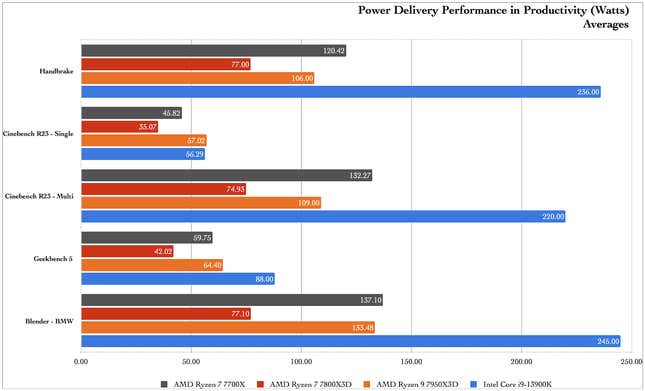
I know that I am not the first person to point this out, but I cannot overstate what these charts show. When it comes to power draw and efficiency, the 7800X3D is like a firm handshake between cost-consciousness and environmental-consciousness. The 7800X3D sips power like wattage is coffee that’s just too hot at the moment while plowing through its processes with enough juice to get the job done.
If you refer back to our gaming performance charts, you will see the 7800X3D drawing less wattage for equal or better performance than the 7950X3D. Even with a higher overall TDP than its fellow Ryzen 7, the 7700X, the 7800X3D shows its dominance in power efficiency. When we look across the aisle, when looking at the Core i9-13900K, the difference is just astronomical.
When it comes to thermal performance, however, the picture is a bit different.
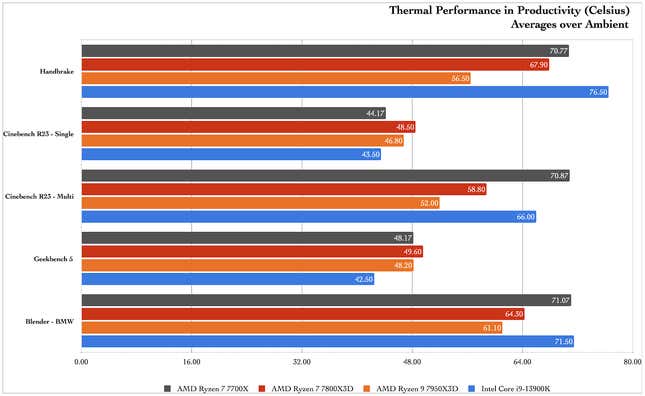
Within the Ryzen 7000 Series, we have been used to seeing some higher numbers when it comes to thermal performance. We weren’t terribly surprised to see the thermal data we collected, but the Ryzen 7 7800X3D did see higher temperatures across the board in both gaming and productivity tests.
However, we mentioned earlier that we had some stability issues while running our encoding benchmark with HandBrake. During these tests, we saw our CPU hit temperatures up to 93C while under load. Keep in mind, this was while being actively cooled by a substantial CPU cooler. With how sensitive the 3D V-cache can be, I wonder if we pushed it too far thermally.

A Pro-Cache Conclusion
If the benefit to gaming performance and the utter dominance of the technology in AMD’s past two CPU generations hasn’t spelled it out, 3D V-cache is here to stay. The Ryzen 7 7800X3D shows dominance within 1080p gaming and incredible power efficiency across gaming and productivity workloads.
So, at $449 USD, is the Ryzen 7 7800X3D worth it?
Like always, that answer depends on what you want to do with it.
This isn’t a terrible CPU for productivity and day-to-day tasks, but it just doesn’t shine as brightly outside of gaming. For $100 less, the Ryzen 7700X is still, in my opinion, one of the more well-rounded CPUs in the product stack, providing solid performance in gaming and productivity.
However, when you look at the power efficiency and gaming performance of the 7800X3D, this CPU is unparalleled in its value proposition for gamers, especially when you look at its retail cost versus its competition. At launch, the 7800X3D is around $100 USD less than Intel’s flagship, the Core i9-13900K, and $350 USD less than AMD’s Ryzen 9 7950X3D.
When evaluating the retail cost and the gaming performance with each of these CPUs, the Ryzen 7 7800X3D upsets the current processor hierarchy to become, without contest, the best value and performer.
The product discussed in this article was provided by the manufacturer for the purposes of review.
[ad_2]


